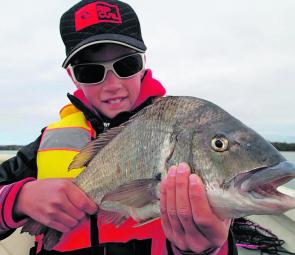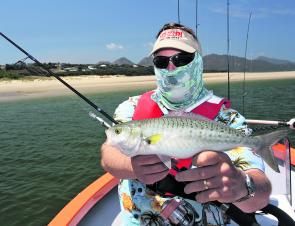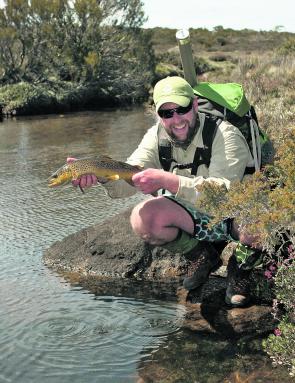If asked for the best month of the year to fish in Tasmania, I’d opt for March.
March has so much going for it – the warm offshore currents bring loads of game fish, the highlands has some sublime trout fishing, the estuaries are as good as ever, especially for bream, and the stream fishing is very good as well.
Northern freshwater options are essentially found in streams that have a reasonable flow. A dry patch in summer means that many streams are at low levels, and while this really doesn’t present too much of an issue for the trout, it will start to make them very spooky during the middle of the day.
Until we get a decent autumn break the best streams will be those that receive a flow from the hydro/irrigation schemes, such as the Macquarie and Brumbies Creek. The South Esk is well worth a look below its confluence with the Macquarie and Meander rivers.
Stream fishing is predominantly based around grasshopper feeders and small mayfly feeders. The mayflies will come back into prominence during the later part of autumn, but until the first big rains and cold snaps the ‘hoppers will reign supreme.
Look for the overhanging banks with dry grass nearby. If a deeper stretch runs along these banks then so much the better. Streams such as the North Esk, St Pats, Meander, Macquarie and South Esk are the prime waters, but those searching further afield should look for any decent flow, especially in the north east.
Lakes such as Huntsman, Brushy Lagoon and Four Springs are really off the agenda until the water cools below 18ºC during the day.
All along the coast and the estuaries that flow into Bass Strait are prime. The Tamar River has warmed up beautifully and a good amount of salt water is all the way up to Dilston, meaning salmon can be found along the entire river below Legana.
Snapper are definitely on the agenda, and while it is something of a ‘black art’ to find these fish consistently, areas around the Batman Bridge, Long Reach and between Shag Rock and Inspection Head are all worth sounding out. Quite a few have been caught around Pipe Clay Bay and similar areas.
King George whiting are increasing in numbers every year, and the Tamar has proven to be a real hot spot for them. Lagoon Beach and the area along the Kelso flats seems to be the best spot, but keen anglers have found good locations for them in other areas. Catching them is relatively simple, finding them is the real key.
The best rig is a simple paternoster rig with a small hook, a light enough sinker to hold the bottom and bait of either pipi or tenderised squid. Some anglers are doing well with soft plastics such as Berkley 6” Sandworms in camp or red.
Yellowtail kingfish are always on the agenda once the water warms sufficiently, and while the action was slow to start, it certainly kicked off with a bang in late January.
In the Tamar the action is most reliable around the Farewell Beacons as these wonderful sports fish feed on masses of baitfish and small squid.
Along the coast, any rocky areas will hold good numbers of big Australian salmon, and as always it seems these days, the kingfish aren’t far away.
Most eyes are on the gamefishing in March, with the warm current now established down the eastern side of Tasmania. Catches of albacore, striped tuna and yellowfin tuna are expected now rather than hoped for, and while yellowfin aren’t a regular catch, albacore and striped tuna are certainly in huge numbers.
Basically the albacore and striped tuna can be targeted in any water deeper than 20m, and most anglers heading out will drop the lures out in anything over 30m of water.
At St Helens small boat operators will focus on Merricks Reef and head deeper if conditions allow, while boats setting forth from Bicheno will be setting a spread of lures pretty much as soon as they clear the Gulch.
Lower down the coast at Eagle Hawk Neck the water will waver between warm enough for yellowfin tuna and cool enough for southern bluefin tuna. This is weather dependant, but generally by the end of March most eyes will be waiting for the SBT run to start in earnest.
Closer in the bays like Georges Bay at St Helens are loaded up with every fish you’d want to catch. Bream on the flats are always exciting when conditions allow, but many anglers are now diverting away from the bream scene into chasing fish like King George whiting and kingfish.
The kingfish can be targeted from the bar way at Georges Bay right up into the upper reaches of the bay depending on where the small salmon go. The deeper stretches of Steiglitz are always worth a good look, especially before the sea breeze gets up.
Estuaries like the Swan and Scamander rivers are always home to huge numbers of bream, and if the aim is just to get a bend in the rod then fish around the mouths of these respective estuaries as the tide runs out for Australian salmon.
Salmon are thick in numbers as they feed on bait heading out with the tide, so any smallish baitfish pattern lure (hardbodied or soft plastic) will do well.
This is the prime month for big bream in the Derwent, and with no national ABT tournament on the Derwent this year there will be less traffic to contend with.
As the whole season was running late, the majority of big bream were still spawning as late as mid January. This delayed the ‘population’ of big bream spots in early summer, with most anglers struggling to find some bream over 35cm. As the season has matured into a ‘normal’ one, the usual haunts along the shores are pretty much back to business as usual.
For the pick of the action look along the western shore between Cadbury’s and the Zinc works and the corresponding locations along the eastern shore. The bays on the eastern shore between Lindesfarne and Ralphs Bay are especially worth working over.
The highlands in March is somewhat enigmatic. One awesome day can lead to a hard day at this time of year – it really is a time of transition. Popular wisdom says that trout feed up hard in preparation for spawning, but I suspect that trout feed whenever conditions are right, irrespective of spawning.
Arthurs Lake is often the go-to spot for lure fishers, especially trollers. The deeper sections of the lake are always super-reliable for trolling around 3-4m deep, especially with lures such as Tassie Devils or deep diving hardbodied lures. Drift casting with soft plastics is also well worth persevering with. Cast around the rocky reefs in the Morass – here are the biggest fish.
Great Lake is my favourite in March, irrespective of imminent spawning, brown trout are always keen to feed on the surface. Quite often at this time of year we see another surge of gum beetles, and Great Lake trout love these like no other.
Head to areas in the north of the lake where they blow off shore in a northerly wind. Places to concentrate on are the whole northern shore from Breona to the outlet and down the eastern shore in bays like Elizabeth Bay and Muddy Bay.
Other lakes that fire in March are Lake Echo and Lake St Clair. Again both of these waters are gum beetle focussed, and if searching for some testing fishing, head to Dee Lagoon in a bright north easter – then you will soon find out how good a fly angler you are!
The western lakes are usually very tough in March, at least until the first cold snap comes through. Low levels and warm water usually slow action, but as water cools they get going again. Waters that have dropped very low will have some stressed trout in there. This isn’t too much to worry about long term, as it pretty much happens every year, but if heading out west look for deeper waters.
Facts
March Best Bets
Salt
Offshore from St Helens and Bicheno for albacore and striped tuna with the good chance of a striped marlin or yellowfin tuna.
Inshore look at Georges Bay, Ansons Bay and the Swan estuary for plenty of big bream and loads of Australian salmon.
Any rocky outcrop along the east coast is worth a look for big salmon or yellowtail kingfish.
King George whiting are a great option in Georges Bay, Tamar River and along the North west coast at Stanley.
Freshwater
Great Lake on warm days when the beetles will take to the wing. On cold days fish the rocky shores with wet flies and lures like soft plastics and gold and black hardbodied lures.
In the streams look for grassy banks from which ‘hoppers can fall. Late in March the small mayflies begin to hatch again in the faster streams.

Boden Buist with a stomping 46cm to the fork bream from a northern estuary. March is a perfect time to chase these very large bream.

Bev Elmer with a typical east coast albacore.

It’s all eyes to the horizon as the boats leave the Burns Bay ramp at St Helens.

Ashley Hallam dictates terms to an Australian salmon at the mouth of the Swan River.

Brendan ‘Beevor’ Turriff scores a great trout in the Christys Creek region of the western lakes.




